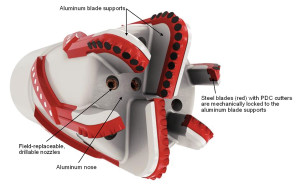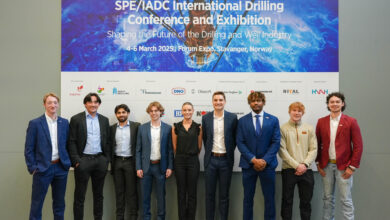Technical Session 14 – Bit Technology
Editor’s note: These abstracts have been edited for space and clarity. This program is current as of 15 January 2013. Additions, withdrawals and other changes to the conference program after this date may not be reflected. Click here for the most updated program.

TECHNICAL SESSION 14: BIT TECHNOLOGY
SPE/IADC 163521
Pointing Toward Improved PDC Bit Performance: Innovative Conical Shaped Polycrystalline Diamond Insert Achieves Higher ROP and Total Footage, M. Azar, A. White, Smith Bits, a Schlumberger Company; M. Taylor, Schlumberger
Vibration induced impact damage can significantly reduce PDC bit/cutter life in hard/abrasive and interbedded formations. To develop a more stable fixed cutter bit for these difficult lithologies, an R&D initiative was launched to investigate new insert designs and experiment with count/placement to improve drilling efficiency and mitigate vibration. The research yielded an innovative conical shaped polycrystalline diamond insert (PDI) with an ultra-thick synthetic diamond layer.
It was run in a North Dakota 8.75-in. vertical section through a highly mixed sequence of formations, where the objective is high ROP and to reach KOP in one run. The bit improved ROP over a longer interval drilled compared to PDCs used in offsets. Additional testing is underway to further evaluate PDI potential and how it can used to improve PDC bit performance.
SPE/IADC 163448
Large Diameter (24 – 26 in. OD) PDC Bit Drilling in Deepwater Gulf of Mexico, P. D’Ambrosio, E. Prochaska, R. Bouska, NOV Downhole; S. Hart, BP; D. Tinsley, Total Energy Services
This paper focuses on the different aspects of large diameter PDC bit drilling in the deepwater Gulf of Mexico and the considerations that have been used to optimize these applications. Conclusions and recommendations will be based on the analysis and evaluation of numerous runs as well as specific case histories. These recommendations will provide a basis for operators to justify a lower cost per foot approach to these large diameter applications.
SPE/IADC 163504
Simulation of Single Cutter Experiments in Evaporites Through Finite Element Method, I.M. Reyes Martinez, S. Fontoura, N. Inoue, C. Carrapatoso, Pontifical Catholic University of Rio de Janeiro; A. Lourenço, D. Curry, Baker Hughes
Single-cutter laboratory experiments are used for evaluating the drill bit – rock interaction mechanisms. These experiments can be simulated through numerical methods to analyze particular conditions of each borehole drilling operation. This paper describes the use of the finite element method for modeling single-cutter experiments in evaporites using a single cutter.
SPE/IADC 163536
Innovative Rolling PDC Cutter Increases Drilling Efficiency Improving Bit Performance in Challenging Applications, Y. Zhang, R.N. Baker, Y. Burhan, J. Shi, C. Chen, Smith Bits, a Schlumberger Company
Extended footage capabilities and high rate of penetration give PDC bits a distinct advantage over rollercone in many applications. However, the fixed PDC element creates an inherent limitation because only a small portion of the cutter contacts the formation, and as the cutters wear/chip, drilling efficiency declines. The industry requires new technology that would effectively utilize the entire diamond cutting edge to reduce frictional heat/wear, while increasing drilling efficiency and bit life.
SPE/IADC 163436
A Breakthrough Performance for an Inland Application with a Hybrid Bit Technology, M. Di Pasquale, E. Calvaresi, Baker Hughes; S. Pecantet, NV Turske Perenco
This paper describes a field experience for a new generation of hybrid bit that is based on proven PDC bit designs with rolling cutters on the periphery of the bit. A hybrid bit can drill shale and other plastically behaving formations up to three to four times faster than a roller-cone bit by being more aggressive and efficient.
A field result compares the performance of hybrid bits with conventional PDC and roller-cone bits used on an offset well, inland application.
SPE/IADC 163524
New Generation Thermally Stable Cutters Deliver High Penetration Rates while Maintaining Durability in the Troll Field, Norway, T.S. Roberts, E. Ludvigsen, M. Bailey, O. Hareid, National Oilwell Varco; C.O. Irgens, Statoil
Following an in-depth study, the drill bit design evolved following several iterations that included computational fluid dynamics to optimize fluid impingement angles and reduce fluid induced shear stress on both the bit body and cutter substrates.
The successful execution of this design with new cutter technology has proven that the combination of improved thermal resistance, with a more efficient cutter geometry, enables the cutters to stay sharp drilling through the hardest stringers and with greater durability to complete the section. The improved designs have now drilled further and faster than any previous attempts.
E-POSTERS:
SPE/IADC 163491
Innovative Hybrid Bit Mitigates Geological Uncertainties, Improves Drilling Performance in Brazilian Pre-Salt Formations, S. Hbaieb, Schlumberger; M.G. Azar, Smith Bits, a Schlumberger company
An innovative hybrid bit design has been successfully applied offshore Brazil to mitigate geological/formation uncertainties in pre-salt formations and eliminate several trips for new bits. This paper will focus on case studies where pre-salt carbonate lithology is non-uniform with a high occurrence of silicate inclusions. The authors will discuss drive system and drilling parameters selection that were critical to achieving the desired performance.
SPE/IADC 163458
Novel Drill Bit Materials Technology Fusion Delivers Performance Step Change in Hard and Difficult Formations, A. Garcia, H. Barocio, R.W. Weeden, National Oilwell Varco; R.A. Quijada, ENI
New drill bit technology capable of drilling these lithologies and performance requirements is unmistakably needed. This paper describes the development of novel drill bit technology aimed at this requirement. This technology is born through the fusion of existing bit technologies; fixed cutter and impregnated diamond and a design philosophy providing greater versatility in drilling a wider range of harsh lithologies, not typically drilled entirely with PDC bits. This novel design philosophy includes optimized cutter placement and exposure of diamond impregnated mix applied in critical areas of the bit.




